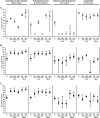Antibiotic-induced perturbations of the intestinal microbiota alter host susceptibility to enteric infection
- PMID: 18678663
- PMCID: PMC2546810
- DOI: 10.1128/IAI.00319-08
Antibiotic-induced perturbations of the intestinal microbiota alter host susceptibility to enteric infection
Abstract
Intestinal microbiota comprises microbial communities that reside in the gastrointestinal tract and are critical to normal host physiology. Understanding the microbiota's role in host response to invading pathogens will further advance our knowledge of host-microbe interactions. Salmonella enterica serovar Typhimurium was used as a model enteric pathogen to investigate the effect of intestinal microbiota perturbation on host susceptibility to infection. Antibiotics were used to perturb the intestinal microbiota. C57BL/6 mice were treated with clinically relevant doses of streptomycin and vancomycin in drinking water for 2 days, followed by oral infection with Salmonella enterica serovar Typhimurium. Alterations in microbiota composition and numbers were evaluated by fluorescent in situ hybridization, differential plating, and Sybr green staining. Antibiotics had a dose-dependent effect on intestinal microbiota composition. The chosen antibiotic regimen did not significantly alter the total numbers of intestinal bacteria but altered the microbiota composition. Greater preinfection perturbations in the microbiota resulted in increased mouse susceptibility to Salmonella serovar Typhimurium intestinal colonization, greater postinfection alterations in the microbiota, and more severe intestinal pathology. These results suggest that antibiotic treatment alters the balance of the microbial community, which predisposes the host to Salmonella serovar Typhimurium infection, demonstrating the importance of a healthy microbiota in host response to enteric pathogens.
Figures






References
-
- Akira, S., T. Hirano, T. Taga, and T. Kishimoto. 1990. Biology of multifunctional cytokines: IL 6 and related molecules (IL 1 and TNF). FASEB J. 42860-2867. - PubMed
-
- Banks, C., A. Bateman, R. Payne, P. Johnson, and N. Sheron. 2003. Chemokine expression in IBD. Mucosal chemokine expression is unselectively increased in both ulcerative colitis and Crohn's disease. J. Pathol. 19928-35. - PubMed
-
- Barthel, M., S. Hapfelmeier, L. Quintanilla-Martinez, M. Kremer, M. Rohde, M. Hogardt, K. Pfeffer, H. Russmann, and W. D. Hardt. 2003. Pretreatment of mice with streptomycin provides a Salmonella enterica serovar Typhimurium colitis model that allows analysis of both pathogen and host. Infect. Immun. 712839-2858. - PMC - PubMed
Publication types
MeSH terms
Substances
LinkOut - more resources
Full Text Sources
Other Literature Sources
Medical

